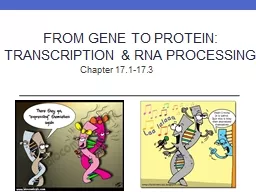

Chapter 171173 Important Terms to Know 25 of students confuse these terms in FRQs Replication Copying of DNA prior to cell division DNA DNA Not prior to transcription ID: 909686
Download Presentation The PPT/PDF document "From Gene to Protein: Transcription &am..." is the property of its rightful owner. Permission is granted to download and print the materials on this web site for personal, non-commercial use only, and to display it on your personal computer provided you do not modify the materials and that you retain all copyright notices contained in the materials. By downloading content from our website, you accept the terms of this agreement.
Slide1
From Gene to Protein:Transcription & RNA Processing
Chapter 17.1-17.3
Slide2Important Terms to Know…25% of students confuse these terms in FRQs!!
ReplicationCopying of DNA prior to cell division (DNA DNA)
Not prior to transcription!TranscriptionMaking mRNA copy from DNA prior to protein synthesis (DNA RNA)TranslationDecoding mRNA and making a protein (RNA Protein)
Slide317.1Genes specify proteins via transcription and translation
Slide4Understanding Genes ProteinsScientists connected metabolic disorders to genes
Ex: alkaptonuriaUrine blackens when exposed to air due to missing enzyme that metabolizes alkaptonBeadle & Tatum studied bread mold
Introduced mutations and saw that mutating certain genes caused metabolic defectsOne gene, one enzyme hypothesisNot all proteins are metabolic (ex: keratin), so hypothesis is now one gene, one polypeptide
Slide5Central Dogma of Molecular Genetics: Crick
Information coded in DNA is transcribed into mRNA and then translated into proteinsDNA
RNA proteinCollectively known as gene expression
Slide6DNA vs. RNA
RNA
Double strandedDeoxyribose sugarBases: A, T, C, GRemains in nucleusDNA
Single stranded
Ribose sugar
Bases: A, U, C, G
U pairs with A
Found in nucleus or cytoplasm
Slide73* Types of RNA
mRNA: carries DNA message from nucleus to cytoplasm
tRNA: carries amino acids from cytoplasm to ribosomerRNA: forms part of ribosomes *other types of RNA exist but we will talk about those later
Slide8Steps in Gene Expression
Transcription RNA processing (eukaryotes only)Translation
Prokaryote
Steps occur simultaneously
Eukaryote
Steps are separate
Slide9The Genetic Code
Made of 3 letter codes: codons (found on mRNA)It is the same in almost all organisms
Redundant: more than one codon for some AA’sNOT ambiguous: each codon codes for 1 amino acid
Slide10Overview of Protein Synthesis
Begins with DNATranscription: in nucleus, DNA message copied into mRNAmRNA is edited prior to leaving the nucleus (eukaryotes)
Translation: mRNA message translated into amino acids at ribosomes
Slide1117.2Transcription is the DNA-directed synthesis of RNA
Slide12TranscriptionComponents necessary:
RNA polymerase enzymeSeparate DNA strand, add RNA nucleotides 5’3’
PromoterDNA sequence where transcription begins Different in prokaryotes and eukaryotesTerminator DNA sequence where transcription endsProkaryotes only
Transcription unit
DNA to be transcribed into mRNA
Slide13Transcription: InitiationRNA polymerase recognizes and binds to promoter “upstream” of gene to be transcribed
RNA polymerase unwinds DNA
Slide14Transcription: ElongationRNA polymerase moves along template strand of DNA adding complimentary RNA nucleotides
Reads in 3’5’ directionThis means mRNA is synthesized 5’3’ direction
A – U; G – C
Slide15Transcription: TerminationTerminator sequence in DNA is transcribedSignals to polymerase to detach from DNA and release transcript
Slide16Slide1717.3Eukaryotic cells modify RNA after transcription
Slide18RNA processing
Eukaryotic mRNA must be modified:Exons: coding sequences of DNA (“ex”pressed)
Introns: non-coding regions, must be cut out by enzymes 5’ cap and poly-A tail added to protect mature mRNA